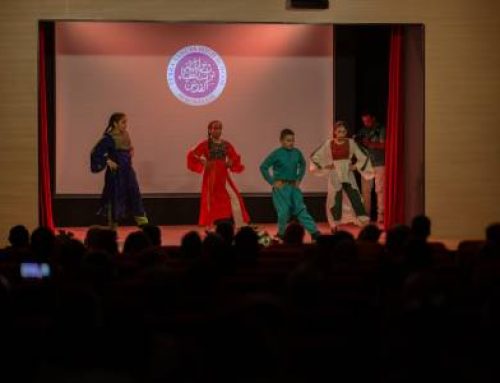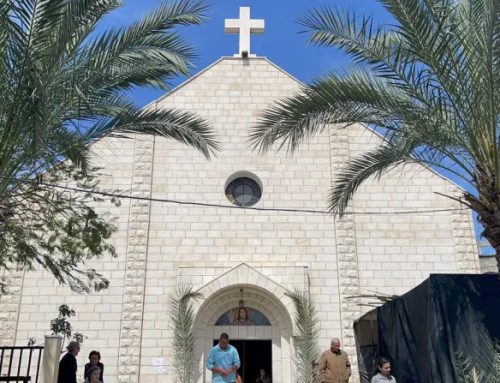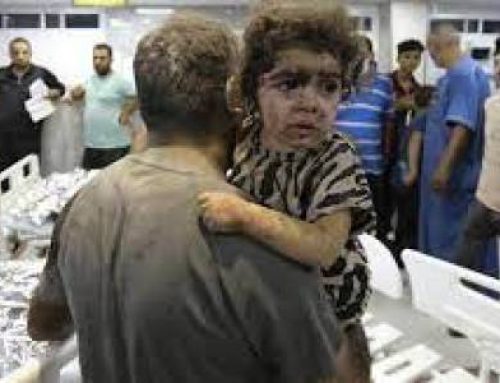Jesus came to Jerusalem shortly after he raised Lazarus from the dead in Bethany, where Lazarus, Mary and Martha lived. Today, Bethany lies behind the wall, with a 30 ft wall separating the path that Jesus would have walked.
Jesus came to Jerusalem shortly after he raised Lazarus from the dead in Bethany, where Lazarus, Mary and Martha lived. Today, Bethany lies behind the wall, with a 30 ft wall separating the path that Jesus would have walked. The church at Bethphage is the traditional site where Jesus mounted the donkey colt and began the entry into Jerusalem with crowds crying out “Hosanna to the King!”
 |
| This mural of the beginning of the Palm Sunday procession is in the church at Bethphage, where the Palm Sunday procession begins every year. |
On Palm Sunday, pilgrims gather from all over the world to participate in the beginning of Holy Week. down the Mt. of Olives through the St. Stephen’s Gate in the Old City. The cacophony of the procession echoes throughout the city until dusk, as the sounds from the drums and bagpipes of the scout troops intermingles with voices raised in countless different languages from the throngs of international pilgrim groups.
When you walk the path that Jesus walked, you walk down the Mt. of Olives, overlooking the panorama of the city and the traditional site where Jesus wept over Jerusalem, lamenting the lack of ability to see the ways that led to peace. Today, you can’t help but hear those words echoing their truth 2000 years later, as various overlooks around the city show both the new separation wall that is tearing through the middle of Palestinian land and life and the valley of Silwan, one of the earliest places where Israelis began home demolitions of those whose children had thrown stones in the first Intifada. Now, 100 homes in Silwan are slated for destruction to make room for an archeological park based on finds whose value are questionable.
O Jerusalem, Jerusalem, when will you learn the ways of peace?
 |  |
Maundy Thursday here for Lutherans begins with an international Eucharist service in several languages at the Lutheran Church of the Redeemer in the Old City. After the service, people gather into different language groups to sing favorite hymns as they process to Gethsemane, about the Church of All Nations to the Russian Orthodox St. Mary Magdelene Church with its beautiful gardens and golden spires. There, in candlelight, more hymns, readings and prayers end the evening.
 |  |
| This is a traditional site called the Cenacle that is believed by some to be the “Upper Room” where Jesus and the disciples celebrated their “Last Supper.” |  |
 |  |
 | There are several places referred to as Gethsemane, which encompasses the lower part of one slope of the Mt. of Olives. This garden is right next to the Church of All Nations, and contains olive trees perhaps as old as Jesus. It is stunning in its beauty and sense of peace. The Church of All Nations is a huge basilica built around a large rock that is the traditional site of Jesus weeping and praying in Gethsemane. Several Mosaics depict this and other scenes from Gethsemane that night. |
 |  |  |
On the slope of Mt. Zion, now outside the Old City walls, is the church of St. Peter in Gallicantu (meaning rooster in French, named for the rooster that crowed after Peter denied Jesus three times). There were ruins of ancient churches and of a house of an obviously wealthy official with what appear to be prison cells. Some claim this was the house of Caiaphus. One of the cells, which prisoners were lowered into through a hole in the ceiling, was the kind in which a political prisoner like Jesus may well have been held.
 |  |
 |  |
Lutherans and Anglicans Join for Via Dolorosa Walk Good Friday
 |  |
 |  |
Easter Sunrise Service on the Mt. of Olives
 |  |
Joint Arabic/English Service in Redeemer Church











